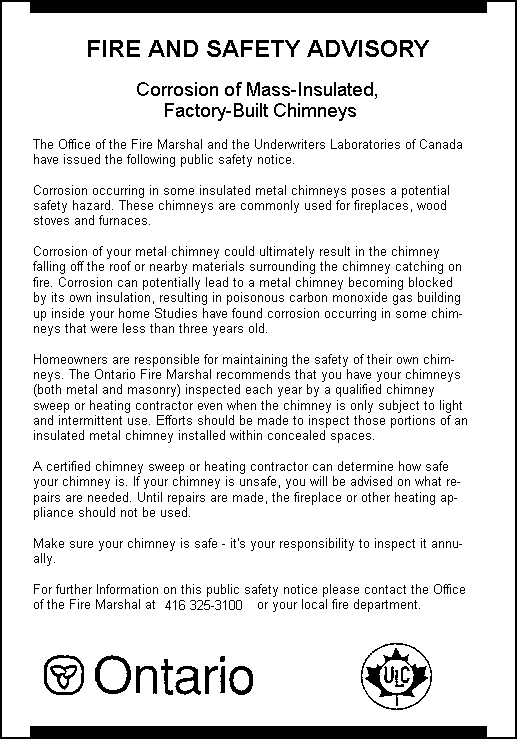
 |
|||
The problem concerns stainless steel chimney flues ("A" vent chimneys) and the silica based insulating material for the interior lining. Either as a result of installation or manufacture, any moisture penetrating the insulation can cause a chemical reaction, resulting in an acid that attacks the metal components. The chimney may prematurely corrode and perforate the casing resulting in a potentially serious fire hazard, that can also lead to carbon monoxide poisoning concerns for unsuspecting residents. In addition, there is a risk of structural damage to the dwelling unit. The increase in the moisture content of the chimney insulation can triple the chimney's weight. Like cancer, the damage is not often visible. It occurs below the roof line and in concealed wall spaces. When it is visible you have a serious problem.
Picture: An Example of a Perforated Chimney
These particular chimneys are common place and have been installed within the last 15 years throughout the country. They are designated as zero clearance, meaning that as little as 5 cm. can exist between the chimney and combustibles.
In Saskatchewan a fatal fire prompted the provincial government to ban these chimneys. In Ontario, chimneys have been found that have fallen off of houses, and recent fires and carbon monoxide gas problems have been traced to defective chimneys. There has been no fatalities (yet) in Ontario but it is just a question of time.
Picture: The original advisory.
The Ontario Fire Marshall (O.F.M.) first issued an alert on this problem back in 1993 but most people are unaware of it. Since then, the O.F.M. has been seeking revisions to the manufacturing standards and approvals listing process, which have not been changed to date. The result is that mass insulated chimneys with these potential risks are still being installed. The public safety notice appears above.
As for our local corporations, the Fire Department has served notice to the Property Managers and the Board of Directors to comply. Their options are simple:
Don't delay inspecting your chimneys, the safety and lives of your residents and the Corporation depend on it.
BULLETIN - AUGUST 12, 1998 - HAZARDOUS CHIMNEYS


1) Certify the chimneys as safe.
2) If found unsafe, remove the fireplace and flue so that the fireplace and chimney is totally disabled or;
3) restore them to a safe condition or;
4) replace the wood appliance with an approved gas installation.
Last Updated by Steve Warner on August 12, 1998